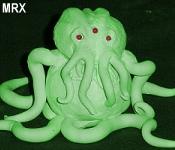I started with small mirrors, which I believe are designed to be used as decorative pillar candle holders (though I don't think they would be very functional in that capacity, at least not if you planned to actually light your candles). They have a nice finished edge and rubber feet, and some even have a beveled edge. They come in a variety of shapes and sizes, and usually cost $1-$10 each depending on size and where you buy them.
The First step is to clean the glass thoroughly with some window cleaner. Then, cover the glass with a piece of vinyl contact paper. Prepare your design. I usually work something up on the computer, and print it out. Occasionally I will hand draw something or use a stencil.
Then use spray adhesive to glue it to the contact paper in the proper position. Next, use an exacto knife to cut out the design, being sure to cut all the way through the paper and the vinyl.
Remove the cut areas that you intend to be etched, but leave the rest covered by the paper and vinyl (or just the vinyl is fine). Coat the exposed area with Armour Etch etching paste. Be sure you get a nice even, thick coat. Leave it on place for 5 minutes. I like to go over it again with my brush applicator at around the 3 minute mark, making sure to brush so that my strokes are perpendicular to the ones made when originally applying it. This helps to make sure that all the little nooks and crannies are covered, and it helps to obscure brush strokes that may be visible in the etched glass. Even coverage is key to not creating blotches and other flaws in the etching.
Don't go much more than 5 minutes. I have found that leaving it on longer (especially with large coverage areas) tends to create uneven etching depth that can look blotchy. After time is up, wash the paste off thoroughly. Then, remove the remaining paper and vinyl and clean the finished piece with window cleaner and a paper towel. Your done. It's that easy!
On this project I attempted to apply some pigment to the etched area to create a colored effect, but my experiment was unsuccessful. While the pigment id grab somewhat to the rougher etched area, it did not cover evenly and created a very blotchy finish that I didn't like, so I cleaned it off.

















No comments:
Post a Comment